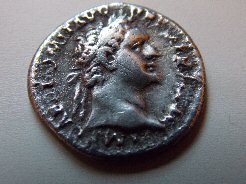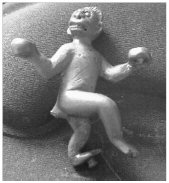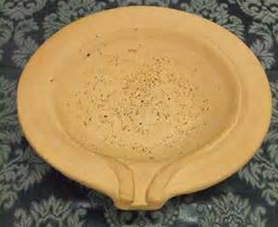An Exciting Set Of Finds By The Field Archaeology Group
July 29th, 2021 in Newsletter
An Exciting Set Of Finds By The Field Archaeology Group
A new site (there I will refer to it as site 3) near Newport is yielding some very fascinating finds as will be seen from the following e-mails from Julian. They have been sent by him to keep those involved with the metal detecting and field walking informed. The content of the e-mails has been adjusted in order to remove any identification of site 3 and because of the importance it has to local, and national, history. (Bryan Lloyd)
12-08-2013 – I’m emailing with the news of a second (site 3), previously unrecorded Roman site to be discovered by our group. The field in question can only be accessed by driving through a farmyard and down a dirt track, this maybe why the site has lain undisturbed until now. The field is on high ground with great views of the surrounding area.
A considerable amount of Roman pottery was found along a strip of ground, some 30 metres wide. This was adjacent the hedgerow near the track-way. Interestingly, outside of the 30 metre strip of land the pottery finds reduce considerably, in fact very few finds were recovered the further away our detectorists and field-walkers walked. The pottery that has been found appears to be the local version of Severn Valley Ware, with a number of pot and jug fragments being recovered. The finds were spread evenly throughout the area adjacent to the hedgerow. Two possible fragments of Samian Ware were found by Ngaire Plowman, one a rim shard and the other a sizeable base fragment.
A Roman silver denarius of Domitian was found by Terry Hayward in the same area as the pottery. The coin has been dated 90-91 AD and appears to have been minted in Rome. I have attached images of the coin sent to me by Terry for all to see.
A woad grinder was also recovered from the same area. It is made from bronze and would have been used for grinding up and applying cosmetics powders. The grinder is identical to an example on page 95 of ‘Celtic and Roman Artefacts’ by Nigel Mills and dates 100BC-100AD.
Fragments of bronze were also found on site and these appear to be the residue from casting. The age of the bronze-work has still to be determined.
The only find of note from outside of the Roman area, was an Edward VI sixpence, found by Paula Jervis. The coin has suffered plough damage but even so is in remarkably good condition.
12-08-2013 I have been talking with the farmer this week regarding the crop marks shown in the aerial photograph and gathering further information relating to the site. It would appear that there is an explanation for all the crop marks! The rectangular feature is in fact a land drain, put in by him. The long line in the field where all the 17th/18th century pottery was recovered was actually a pathway formed by vehicles taking food down to the feeding station for the sheep which were grazing the field and finally the circular feature is a pit filled in by his father many years ago! So much for the crop marks! A useful lesson though, in reading the landscape.
The farmer has informed us of the location of a spring, just a few metres from where we recovered most of our pottery. This is not the only spring as the farmer who owns the land next to this site also has a spring adjacent to an outcrop of sandstone. This may have had a settlement close by. The site on which we are searching may also have been a settlement. I have also found out that a water mill was sited at the far end of the field where the slip ware pottery was found. The feed pools still exist although the mill and the mill leet are long gone.
Unfortunately the field we’re all waiting to get on will not be ready until Tuesday! So we will have to wait for the following Sunday. However, the farmer has informed me that he will allow us to field-walk and metal detect the site directly after ploughing, but only for the following Sunday after each field is ploughed. He intends to begin ploughing on the 7th September.
Finally, I have attached images of a Commonwealth Half Groat, that Terry Hayward found just before leaving the site last Sunday. Interestingly it has had a hole punched in it so it may have been used as a charm or worn by a supporter of Oliver Cromwell’s English Republic.
16-08-2013 – I visited Peter Reavill today and dropped off the finds from “The Buttery” and Forton. I also took the opportunity to show him my finds from site 3, the results of which I will come to later.
The pottery from Forton is a bit special, firstly we appear to have recovered a small number of Iron Age pot fragments. If these are confirmed as such, then they will be the first recorded by our group and the first from Forton.
A significant amount of Roman pottery was also identified, suggesting that a Romano-British building either stood in the field, or close by. The pottery is the local version of Severn Valley Ware and has been dated 100-300 AD.
The Medieval pottery recovered dates from 1200-1450 AD and its spread across the field, again, suggests that Medieval dwellings once stood in the field opposite the Hall. The oldest metal object, found by the group at Forton, was a double looped swivel buckle found on our first visit to Forton by Terry Hayward, this is intact and as a result is a very rare artefact. This dates from the 12th century.
The finds from “The Buttery” were also found to be Roman. All of the pottery found in the Roman field by Andrew Jervis turned out to be just that, Roman! Just as with Forton. all the fragments were the local version of Severn Valley Ware, dating 100-300 AD. The Roman coins found by Terry Hayward are contemporary with the pottery and are of the Emperor Marcus Aurelius 131-161 AD.
The statue of the Monkey is a little more difficult to date, Peter has confirmed that it has many Roman characteristics, although the statue’s stance is eastern in look, according to one of the experts at the British Museum.
Finally, I took along my finds from site 3. Peter confirmed that all of the pottery and what looks like building debris is Roman!! All of it dates from the same period as the previous sites, 100-300 AD. The pottery is made up of the local version of Severn Valley ware and the local version of Samian Ware. The local form of Samian Ware is apparently particularly rare for our area and seems to strongly suggest that we are dealing with a very high status site!
The woad grinder recovered last Sunday is another high status item and has been dated 100 BC-100 AD.
Peter will be holding a “Finds Day” in 3a on Saturday 2nd November.
25-08-2013 – The Roman site, site 3, continues to produce an amazing array of finds. Two Roman pot bases were found today by Mike Abbott, both are surprisingly large and well preserved examples. The first was the base and side of a mortarium (mixing bowl) and the other, the base of a Samian bowl. More Severn Valley Ware pot shards were also recovered, all from the same area as previously field-walked on our previous visits to the site. This may in part be due to the heavy rain we have had recently, washing away the soil to reveal more pottery.
The detectorists are still having to work hard to find any metal artefacts, however, when they do, they are well worth the effort. Terry Hayward found our first Roman brooch from the site and this has proved to be a little bit special being made of lead rather than bronze (picture attached).
.
Paula Jervis also found something a little bit special, a large bronze disc. It appears to be around 4 inches in diameter with a small circular disc in its centre, which appears to be the fixing point. It has a rich green patina, so I suspect it dates from the same period as the woad grinder. Possible shield decoration? One for Peter Reavill!! Martin James found an extremely worn example of a William III shilling in one of the adjacent fields. This may have been destined to be turned into a love token, but was lost before its owner could do so. The only other find of note was a flint blade found by Chris Maudsley, almost certainly Neolithic in date and a really fine example. Even after 4000 years its sides are still sharp!
Although the fields surrounding the Roman site have produced 17th/18th century pottery and related metal artefacts, no Roman finds have been recovered. This suggests that we are dealing with a relatively undisturbed site with the majority of the finds concentrated in a small area. To prove this beyond doubt we will need to field-walk and metal detect the field directly behind the site, which has produced all the Roman finds so far. Hopefully the weather will be kind to us and the crop can be harvested this week.
The large collection of Roman material recovered from site 3 will be on display in the Heritage Centre in the next few weeks. I feel it should eventually be a permanent display, as it is the largest, best preserved and most complete collection of Roman artefacts ever recovered by our group.
27-08-2013 I have just been researching our finds from last Sunday and found these images of a mortarium. The first one is a replica (Ludlow Museum) and the second one is a genuine 1st century Roman mortarium
Replica moratium – Ludlow Museum
Genuine Roman mortarium
Site 3 – A Roman Military Site??28-08-2013 – Yes you read the title correctly, Peter Reavill has contacted me this afternoon and is a little excited to say the least. The shield decoration has turned out to be the base of a bronze dish and dates from 60-175 AD. These dishes were issued to Roman soldiers in the 1st century AD examples were found in the ditch infill surrounding the original fort at Wroxeter. Only five known examples have been recovered from the county, all from Roman military sites.
The lead Roman “brooch” is in fact a mould for Poldin Hill (bronze) brooches and is an extremely rare artefact. This again can be dated to 75-175 AD. Peter asked if we have found bronze fragments whilst detecting the site, and we have! Around five pieces of bronze which have clearly come from a mould.
28-08-2013 Peter Reavill contacted me this afternoon with information regarding some our finds from site 3. It would appear the bronze disc found by Paula Jervis is not a fragment of Iron Age shield decoration, but is in fact the base of a patera cooking pot. These pots were used by the Roman army and form part of the cooking kit that each soldier carried. Peter has suggested that this may indicate that the Roman military were at Wall and that they stayed for quite a while, to control the local area. The remains of a patera pot were recovered from the ditch fill at the legionary fortress at Wroxeter, which dates from around 60-80 AD. So this is an important find. Only 5 others have been found in the county and all from military sites! The fact that melted scrap bronze has been recovered from the site confirms that bronze casting was taking place and ties in with the discovery of the lead pattern. All the examples recorded by the Portable Antiquities Scheme are for casting Poldin Hill brooches and date 75-175 AD.
A patera is a Roman skillet – a personal cooking pot.
I am sorry that so much space has been taken up by just one article, but I am sure that you will all agree, that the site mentioned, is so important to the history of the Newport area, and apparently nationally, that the account had to be presented almost in its entirety. Further justification is that the praises of Julian and his group must be sung in the highest degree for the dedication, hard work and professionalism that they have shown in their endeavours – and, I am sure,there will be more interesting finds to come!.
Bryan Lloyd





